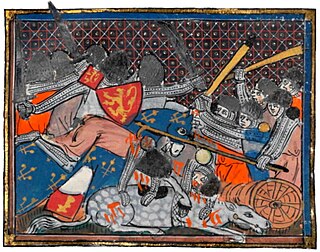
Reynard the Fox is a literary cycle of medieval allegorical Dutch, English, French and German fables. The first extant versions of the cycle date from the second half of the 12th century. The genre was popular throughout the Late Middle Ages, as well as in chapbook form throughout the Early Modern period.

Joan, often called Joan of Constantinople, ruled as Countess of Flanders and Hainaut from 1205 until her death. She was the elder daughter of Baldwin IX, Count of Flanders and Hainaut, and Marie of Champagne.

The Battle of the Golden Spurs was a military confrontation between the royal army of France and rebellious forces of the County of Flanders on 11 July 1302 during the Franco-Flemish War (1297–1305). It took place near the town of Kortrijk (Courtrai) in modern-day Belgium and resulted in an unexpected victory for the Flemish. It is sometimes referred to as the Battle of Courtrai.
Dutch language literature comprises all writings of literary merit written through the ages in the Dutch language, a language which currently has around 23 million native speakers. Dutch-language literature is the product of the Netherlands, Belgium, Suriname, the Netherlands Antilles and of formerly Dutch-speaking regions, such as French Flanders, South Africa, and Indonesia. The Dutch East Indies, as Indonesia was called under Dutch colonization, spawned a separate subsection in Dutch-language literature. Conversely, Dutch-language literature sometimes was and is produced by people originally from abroad who came to live in Dutch-speaking regions, such as Anne Frank and Kader Abdolah. In its earliest stages, Dutch-language literature is defined as those pieces of literary merit written in one of the Dutch dialects of the Low Countries. Before the 17th century, there was no unified standard language; the dialects that are considered Dutch evolved from Old Frankish. A separate Afrikaans literature started to emerge during the 19th century, and it shares the same literary roots as contemporary Dutch, as Afrikaans evolved from 17th-century Dutch. The term Dutch literature may either indicate in a narrow sense literature from the Netherlands, or alternatively Dutch-language literature.
John II was Count of Hainaut, Holland, and Zeeland.
De Vos is a Dutch-language surname meaning "the fox". In 2007 in the Netherlands, nearly all ≈11,000 people with the name spelled it de Vos, while in 2008 in Belgium, primarily in East Flanders, nearly all ≈11,000 people with the name capitalized it De Vos. Another 9220 people in Belgium, mostly in West Flanders have the concatenated form Devos, while in the United States the form DeVos can be found.
Flemish literature is literature from Flanders, historically a region comprising parts of present-day Belgium, France and the Netherlands. Until the early 19th century, this literature was regarded as an integral part of Dutch literature. After Belgium became independent from the Netherlands in 1830, the term Flemish literature acquired a narrower meaning and refers to the Dutch-language literature produced in Belgium. It remains a part of Dutch-language literature.
Hinrek van Alckmer, also known as Hendric van Alckmaer, Henrik van Alkmer and Henry of Alkmaar, was a 15th-century Middle Dutch author who wrote one of the principal published versions of Reynard the Fox in 1487.
Middle Dutch literature (1150–1500) is the Dutch literature produced in the Low Countries from the 12th century to the 16th century. It is preceded by only a few fragmentary texts existing in Old Dutch, and it was succeeded by Dutch Renaissance and Golden Age literature.

Folklore of the Low Countries, often just referred to as Dutch folklore, includes the epics, legends, fairy tales and oral traditions of the people of Belgium, Netherlands and Luxembourg. Traditionally this folklore is written or spoken in Dutch or in one of the regional languages of these countries.
The Willemsfonds, named after Jan Frans Willems, is a non-profit cultural organisation founded in the 19th century to promote Flemish culture and language in Belgium. In order to achieve this goal, the organisation encouraged Flemish folk song, organised linguistic games and published inexpensive Flemish books. In addition, the organisation established general libraries.

Paul Claes is a Flemish scholar, writer, poet and translator.

Robert van Genechten was a Belgian-born Dutch politician and writer and a leading collaborator during the German occupation of the Netherlands.
Willem die Madocke maecte is the traditional designation of the author of Van den vos Reynaerde, a Middle Dutch version of the story of Reynard the Fox.
Willem Adriaan Gerrit Anton ("Harry") Bouwman is a Dutch Information systems researcher, and professor at the Åbo Akademi University, Institute for Advanced Management Systems Research, known for his work on mobile services, business models and business architecture.
Ernst Eduard Martin was a German philologist of Romance and Germanic studies. He was the son of gynecologist Eduard Arnold Martin (1809–1875).

Léonard Willems (1864–1938) was a Flemish philologist from Brussels, Belgium, who was active in academic circles in Ghent.








